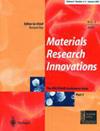In vitro and in vivo toxicological evaluation of green synthesised anatase TiO2 nanoforms
Q2 Engineering
引用次数: 1
Abstract
ABSTRACT The present study aims at the evaluation of in vitro and in vivo toxicities of green TiO2 nanoparticles (GS-TiO2) that are biosynthesised using hydroalcoholic extract of Ocimum sanctum leaves using microwave energy. Commercially available TiO2 NPs (CS-TiO2) were used for comparison. In vitro hemotoxicity was evaluated using haemolysis assay, and viability of fibroblast cells using WST-8 assay. In vivo toxicity evaluation was performed using the silkworm model. Haemolysis assay showed that GS-TiO2 caused acceptable haemolysis of 2.3% and CS-TiO2 showed higher haemolysis of 4.4%. As per WST-8 assay, viability of fibroblast cells was better in groups treated with GS-TiO2 with more than 50% survival. Silkworm growth parameters were significantly improved in GS-TiO2-treated batches. At the biomolecular level, changes in haemolymph protein banding patterns indicated strong growth promoting potential of GS-TiO2. Considering the salient findings derived from toxicity results, we propose that GS-TiO2 shall be potent NPs for various biomedical applications.绿色合成锐钛矿TiO2纳米形态的体内外毒理学评价
摘要:本研究旨在评价绿色二氧化钛纳米粒子(GS-TiO2)的体外和体内毒性,该纳米粒子是利用微波能量生物合成的。采用市售的TiO2 NPs (CS-TiO2)进行比较。采用溶血法评估体外血液毒性,采用WST-8法评估成纤维细胞活力。采用家蚕模型进行体内毒性评价。溶血实验表明,GS-TiO2溶血率为2.3%,CS-TiO2溶血率较高,为4.4%。WST-8实验结果显示,GS-TiO2处理组成纤维细胞存活率较高,存活率超过50%。gs - tio2处理批次的家蚕生长参数显著改善。在生物分子水平上,血淋巴蛋白带模式的变化表明GS-TiO2具有很强的促生长潜力。考虑到从毒性结果中得出的显著发现,我们建议GS-TiO2应该是各种生物医学应用的有效NPs。
本文章由计算机程序翻译,如有差异,请以英文原文为准。
求助全文
约1分钟内获得全文
求助全文
来源期刊

Materials Research Innovations
工程技术-材料科学:综合
CiteScore
5.20
自引率
0.00%
发文量
38
审稿时长
2.8 months
期刊介绍:
Materials Research Innovations covers all areas of materials research with a particular interest in synthesis, processing, and properties from the nanoscale to the microscale to the bulk. Coverage includes all classes of material – ceramics, metals, and polymers; semiconductors and other functional materials; organic and inorganic materials – alone or in combination as composites. Innovation in composition and processing to impart special properties to bulk materials and coatings, and for innovative applications in technology, represents a strong focus. The journal attempts to balance enduring themes of science and engineering with the innovation provided by such areas of research activity.
 求助内容:
求助内容: 应助结果提醒方式:
应助结果提醒方式:


